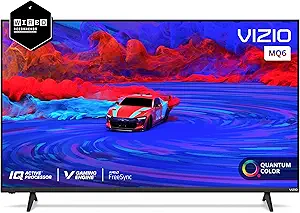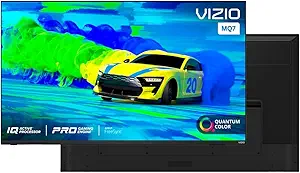The television market is flooded with various brands, each vying for a spot in consumers' living rooms. Among the contenders, Hisense and Vizio have emerged as formidable players, offering a range of feature-packed and competitively priced TVs. In this article, we'll delve into the details of the Hisense vs Vizio TV battle, exploring their strengths, weaknesses, and key differences to help you make an informed decision when choosing your next television.
Key Features Comparison
Picture Quality
Top-Rated Picture Quality Brands
The picture quality of Hisense and VIZIO televisions varies significantly due to their respective technologies and features. Hisense televisions, particularly the ULED models, are known for their impressive picture quality. They use Quantum Dot technology that delivers better brightness and colors, along with Dolby Vision HDR that enhances the contrast. However, some users have reported inconsistency in black uniformity and minor issues with motion handling. On the other hand, VIZIO televisions, especially the P-Series Quantum models, also offer excellent picture quality. They utilize Quantum Color technology, providing a wide color range and impressive brightness levels. VIZIO TVs also support Dolby Vision HDR, HDR10+, and HLG, ensuring high dynamic range content. However, the local dimming feature, which is supposed to improve the contrast ratio, is sometimes reported to cause blooming around bright objects. When compared to other brands, both Hisense and VIZIO offer competitive picture quality, often surpassing their price counterparts. However, high-end brands like LG and Samsung may still hold the upper hand in terms of overall picture quality.
Design
When it comes to design, both Hisense and VIZIO televisions offer a sleek and modern aesthetic that complements any living room setting. Hisense televisions, in particular, are known for their slim bezels and minimalist design. The latest models, such as the Hisense U8G Quantum series, offer a nearly bezel-less design that maximizes the screen real estate, providing an immersive viewing experience. The stand design is also quite sturdy and minimalistic, which adds to the overall sleek look of the television. However, some users have reported that the build quality feels a bit plasticky, which might slightly detract from the premium feel. On the other hand, VIZIO televisions also boast a sleek and modern design. Models like the VIZIO P-Series Quantum X have a solid build quality with a metal frame and stand that exudes a more premium feel compared to the Hisense models. The bezels are also quite thin, although not as thin as those on the Hisense models. One potential downside of VIZIO's design is that the stand is quite wide, which might not fit on smaller TV stands or tables. Overall, both brands offer aesthetically pleasing designs, but VIZIO seems to have a slight edge in terms of build quality, while Hisense leads in terms of bezel thinness.
Sound
Top-Rated Sound Quality Brands
Hisense and VIZIO televisions are recognized for their exceptional sound quality, which is an essential aspect of the overall viewing experience. Hisense televisions are equipped with Dolby Atmos technology, which provides immersive, multi-dimensional sound. The sound system of Hisense TVs is designed to deliver crisp, clear audio that fills the room and enhances the viewing experience. The integrated subwoofers also provide deep, rich bass for a more immersive experience. However, some users have reported that the sound can be a bit tinny at higher volumes. On the other hand, VIZIO televisions feature built-in DTS Virtual:X technology that promises to deliver a full, immersive sound experience. This technology provides multi-dimensional sound, giving the illusion of sound coming from all directions. VIZIO also offers sound bars that can be paired with the TVs for an enhanced audio experience. The sound quality of VIZIO TVs is generally praised for its clarity and volume, but some users have reported inconsistencies in sound levels when switching between different inputs or apps. Compared to other brands, both Hisense and VIZIO offer competitive sound technologies that enhance the overall viewing experience.
Quality & Performance
Hisense and VIZIO televisions are both renowned for their quality and performance, each offering unique features and technologies. Hisense televisions are equipped with the latest technologies such as Quantum Dot Color, Dolby Vision HDR, and Full Array Local Dimming, which contribute to a high-quality viewing experience. The Quantum Dot Color technology offers a wider color spectrum, creating vibrant and lifelike images. However, some users have reported issues with the longevity of Hisense TVs, stating that they sometimes fail after a few years of use. On the other hand, VIZIO televisions are known for their superior performance and quality. They come with technologies such as Active Full Array backlighting and Quantum Color, which deliver deep blacks and bright, vibrant colors. VIZIO TVs are also equipped with SmartCast, a smart TV platform that allows for streaming from several apps, and voice control capabilities. Despite these features, some users have reported the TVs having slower response times and less intuitive user interfaces compared to other brands. When compared to Hisense, VIZIO TVs are often praised for their longevity and consistent performance. Both brands offer competitive quality and performance, but the choice between the two may depend on personal preference and specific feature requirements.
Conclusion
The Hisense vs Vizio TV comparison showcases two reputable brands with distinct strengths. Choosing between them depends on your specific preferences, budget constraints, and the features that matter most to you. Whether you prioritize picture quality, performance, or audio, both brands have something to offer. Take the time to compare specific models within your desired price range to find the TV that best suits your needs and elevates your home entertainment experience.



















